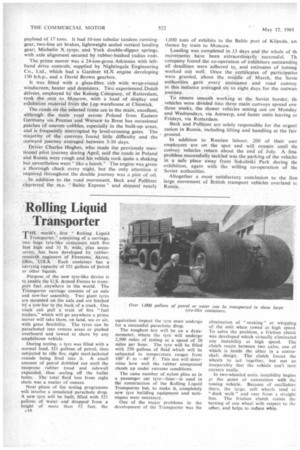Rolling Liquid Transporter
Page 54

If you've noticed an error in this article please click here to report it so we can fix it.
T"Nvorld's , first " Rolling Liquid Transporter," consisting of a carriage, two huge tyre-like containers each five feet high and 3+ ft. wide, plus accessories, has been developed by rubberresearch engineers of Firestone, Akron, Ohio, U.S.A. Each container has a carrying capacity of 521 gallons of petrol or other liquids.
Purpose of the new tyre-like device is to enable the U.S. Armed Forces to transport fuel anywhere in the world. The Transporter carriage consists of an axle and tow-bar assembly. Two giant tyres are mounted on the axle and are hitched by a tow-bar to the back of a truck. One truck can pull a train of five "fuel trailers," which will go anywhere a prime mover will take them, on land, sea or air, with great flexibility. The tyres can be parachuted into remote areas or pushed overboard and towed to shore by any amphibious vehicle.
During testing, a tyre was filled with a normal load, 521 gallons of petrol, then subjected to rifle fire, eight steel-jacketed rounds being fired into it. A small amount of petrol dribbled out until the neoprene rubber tread and sidewall expanded, thus sealing off the bullet holes. The total fluid loss from eight shots was a matter of ounces.
Next phase of the testing programme will involve a simulated parachute drop. A new tyre will be built, filled with 521 gallons of water and dropped from a height of more than 12 feet, the
cl
equivalent impact the tyre must undergo for a successful parachute drop.
The toughest test will be on a dynamometer, where the tyre will undergo 2,500 miles of testing at a speed of 20 miles per hour. The tyre will be filled with 250 gallons of fluid which will be subjected to temperature ranges from 100° F. to —40° F. This test will determine how well the rubber compound stands up under extreme conditions.
The same number of nylon plies as in a passenger car tyre—four—is used in the construction of the Rolling Liquid Transporter but, to make it, completely new tyre building equipment and techniques were necessary.
One of the major problems in the development of the Transporter was the
elimination of "snaking" or whipping of the unit when towed at high speed. To solve the problem, a friction clutch was developed which virtually eliminated any instability at high speed. The clutch reacts between two axles, one of which is inside the other in a centreshaft design. The clutch forces the wheels to act together, but not so inseparably that the vehicle can't turn corners easily.
In two-wheeled units. instability begins at the point of connection with the towing vehicle. Because of oscillation there, the large, soft wheels tend to "duck walk" and veer from a straight line. The friction clutch resists the turning of one wheel with respect to the other, and helps to reduce whip.
























































































































